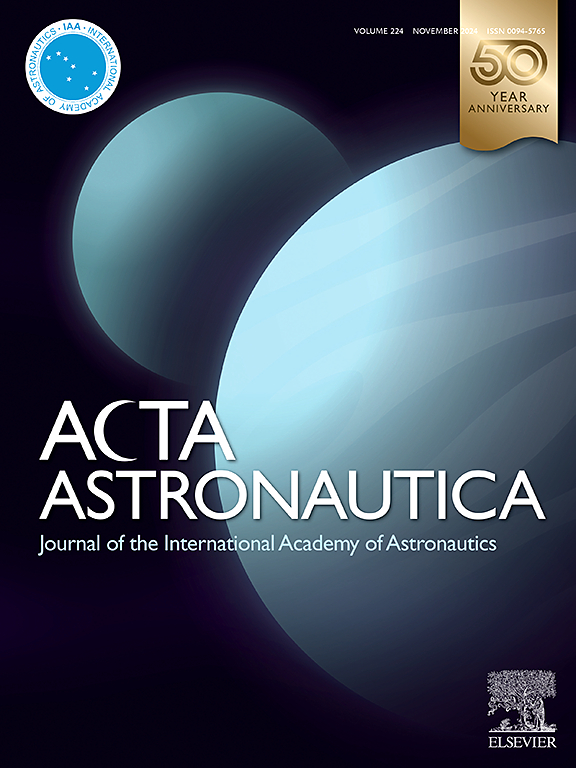Methodology for robust analysis of bolts slippage in cryogenic space missions
IF 3.1
2区 物理与天体物理
Q1 ENGINEERING, AEROSPACE
引用次数: 0
Abstract
The assessment of slippage in cryogenic space missions is fundamental from a mechanical point of view as it is one of the main failure modes of a bolt in a mechanical interface. It is usually performed on the basis of temperature maps obtained from the worst-case thermal design cases, with particular interest in the transient case during the cooldown. Traditionally, the thermal mapping has to be transferred to the detailed FEM model. This process requires a lot of interaction between the thermal and structural disciplines, which is often not easy. Moreover, the thermal mapping usually corresponds to the instant of maximum gradient between the clamped parts along the transient case. In this paper, a new methodology is proposed to speed up the evaluation of the temperature effect on the slippage from an analytical model correlated with the FEM model. Then, the interactions between the structural and the thermal responsible may be reduced. In addition, the proposed methodology evaluates the entire temperature curve of the transient case, rather than a single instant. In this way, the thermal effect on slippage can be evaluated in a robust and agile process, facilitating the definition of requirements in terms of the maximum allowable temperature gradient as a function of preload or vice versa. This methodology has been validated with the primary mirror of the ARIEL mission, which is a cryogenic European mission that aims to study exoplanets by making observations from a thermally stable orbit at L2 point of the Sun-Earth system. Therefore, the correct design of the primary mirror is essential for the successful science observations of the mission.
低温空间飞行任务中螺栓滑移的稳健分析方法
从机械角度来看,低温空间飞行任务中的滑动评估是非常重要的,因为它是机械接口中螺栓的主要失效模式之一。通常是根据最坏情况下的热设计案例获得的温度图进行评估,尤其关注冷却过程中的瞬态情况。传统上,热映射必须转移到详细的有限元模型中。这一过程需要热学和结构学科之间的大量互动,通常并不容易。此外,热映射通常与瞬态情况下夹紧部件之间的最大梯度瞬间相对应。本文提出了一种新方法,通过与有限元模型相关的分析模型,加快评估温度对滑移的影响。这样就可以减少结构和热影响之间的相互作用。此外,所提出的方法还能评估瞬态情况下的整个温度曲线,而不是单个瞬间。这样,就能以稳健、灵活的方式评估热效应对滑移的影响,从而便于根据最大允许温度梯度作为预紧力的函数或反之亦然来定义要求。这一方法已通过 ARIEL 任务的主反射镜进行了验证,ARIEL 是欧洲的一项低温任务,旨在通过从太阳-地球系统 L2 点的热稳定轨道上进行观测来研究系外行星。因此,主镜的正确设计对于该飞行任务成功进行科学观测至关重要。
本文章由计算机程序翻译,如有差异,请以英文原文为准。
求助全文
约1分钟内获得全文
求助全文
来源期刊

Acta Astronautica
工程技术-工程:宇航
CiteScore
7.20
自引率
22.90%
发文量
599
审稿时长
53 days
期刊介绍:
Acta Astronautica is sponsored by the International Academy of Astronautics. Content is based on original contributions in all fields of basic, engineering, life and social space sciences and of space technology related to:
The peaceful scientific exploration of space,
Its exploitation for human welfare and progress,
Conception, design, development and operation of space-borne and Earth-based systems,
In addition to regular issues, the journal publishes selected proceedings of the annual International Astronautical Congress (IAC), transactions of the IAA and special issues on topics of current interest, such as microgravity, space station technology, geostationary orbits, and space economics. Other subject areas include satellite technology, space transportation and communications, space energy, power and propulsion, astrodynamics, extraterrestrial intelligence and Earth observations.
 求助内容:
求助内容: 应助结果提醒方式:
应助结果提醒方式:


